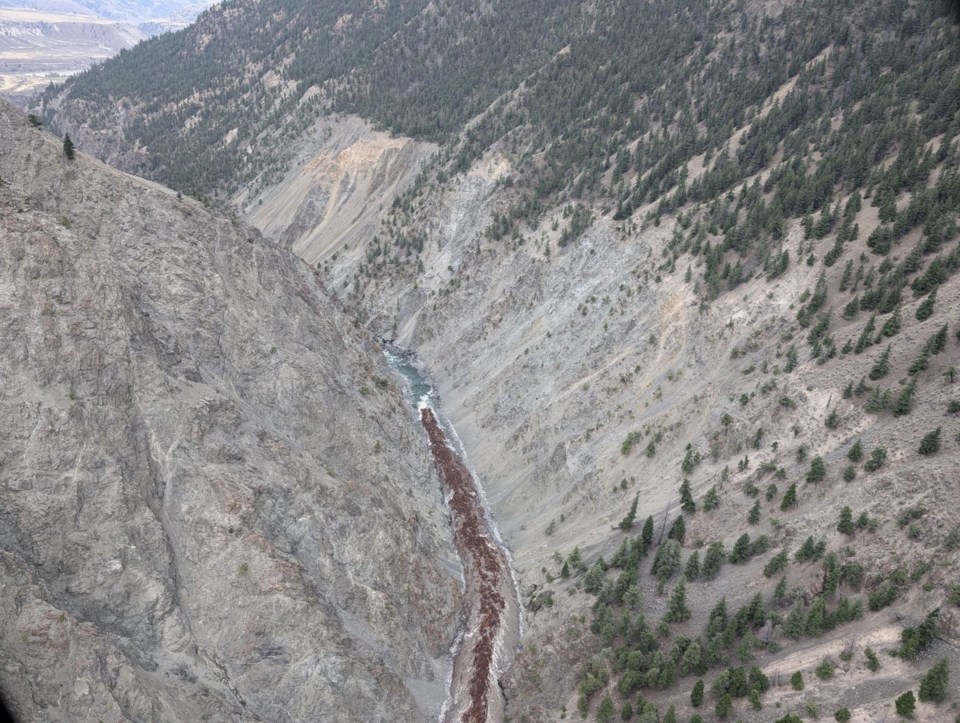Max Paulhus says he could hear wood breaking and a roaring sound before an approaching surge of water raced down the Fraser River after breaking free from a landslide upstream.
Paulhus lives in Lillooet, B.C., and is one of several Fraser River community residents and business operators who described watching the power of water and debris churning from the Chilcotin River landslide towards British Columbia's Lower Mainland.
"You could hear an abnormal sound coming from the river," said Paulhus, Lillooet and District Rescue Society chief. "You could hear that noise. You could hear branches breaking. It was almost like a roar."
Others downstream at Lytton and at the Hell's Gate Airtram said they could also hear the river's flow as the water and debris passed through Tuesday afternoon and evening.
A landslide last week in Farwell Canyon, south of Williams Lake, dammed the Chilcotin River and created a lake about 11 kilometres long behind the slide.
Water started flowing over the top of the landslide on Monday, and as the dam eroded a torrent of water raced down the Chilcotin, a tributary of the Fraser River, ripping away river banks and carrying off at least one heritage cabin.
Lytton First Nation Coun. John Haugen said he estimated the Fraser River rose about three metres Tuesday, before it returned to normal levels Wednesday.
"The water dropped about 10 feet at about 5:30 this morning," he said, adding the high-water marks were still visible at the community's river ferry dock.
Haugen said the water flow was similar to spring runoff conditions but there was far more debris in the river.
"There's a lot more activity in the water with the logs crashing into each other," he said. "That makes a sound as well as the real onslaught of the water. It has a lot of power."
At Boston Bar's Hell's Gate Airtram, one of the narrowest sections of the Fraser Canyon, water was still surging Wednesday and debris accumulating, said operations manager William Wu.
"I'd say today the water level is a little bit higher than yesterday," he said in an interview Wednesday. "There's lots of logs and muddy water up here."
Wu said there are concerns about the logs clogging the river at Hell's Gate, but the materials are moving downstream.
He said there has been a surge of business at the airtram with people coming to see the surge of water released by the dam break.
Emergency Management Minister Bowinn Ma said Tuesday she was "grateful" the threat of a flood disaster along the Chilcotin and Fraser rivers appeared to have been averted when the lake drained overtop of a landslide.
High waters similar to spring runoff conditions were being observed downstream, but dangers still exist from the powerful current carrying trees and other debris, she said.
Chief Joe Alphonse, Tsilhqot'in National Government tribal chair, said Tuesday the slide and damage from the rushing water could impact critical salmon runs heading for spawning areas upstream on the Chilcotin River and at Chilko Lake.
The valuable sockeye salmon run, currently making its way up the Fraser River, is due to arrive at the Chilcotin River this weekend, while some Chinook have passed by the slide area, but others are still in the river downstream from the slide, he said.
The Tsilhqot'in launched an emergency salmon task force to call on all levels of government, including U.S. states, to take measures to preserve the sockeye and chinook stocks.
At a news conference, Alphonse called on the Fisheries Department to introduce "automatic" sport and commercial fishing restrictions to protect Chilcotin River and Chilko Lake salmon.
The Fisheries Department said in a statement Tuesday that based on historical timing, it believes the majority of adult chinook salmon returning to the Chilcotin River this season migrated past the slide site before last week's landslide.
It also said the majority of adult sockeye salmon are expected to arrive at the confluence of the Chilcotin and Fraser rivers around the third week in August, and coho not until the early fall.
Paulhus said Lillooet and District Rescue Society members and local officials were prepared to "knock on doors" if the waters were threatening to flood the community, but that did not occur.
Haugen said at least one First Nation resident living close to the river left his home ahead of the water surge, but the property did not flood.
The Lower Mainland cities of Maple Ridge and New Westminster closed access to Fraser River public areas out of caution in case of swift moving water and debris.
This report by The Canadian Press was first published Aug. 7, 2024.
Dirk Meissner, The Canadian Press



